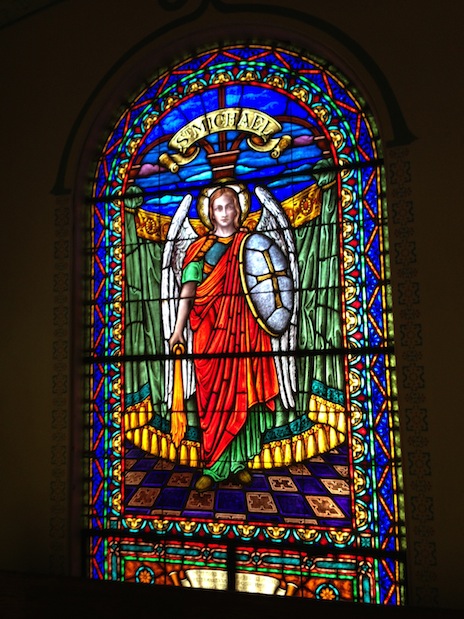Educational Information
This page has information about St. Michael's church as well as the Orthodox faith in general.
Who is St. Michael?
St. Michael is a guardian angel who watches over and protects all those who serve God. He is the Defender of the Faith. In Hebrew, “Michael” means “One who is like God.” Icons of St. Michael are written with him holding a double-edged sword. The two edges are truth and justice.
St. Michael is the most powerful of the four principle archangels (the other three are Gabriel, Raphael, and Uriel). In both the Old and New Testaments, St. Michael stands against the forces of Hell. St. Michael is the ideal warrior for God, always exhibiting courage and loyalty. His battles are won not by his own efforts, but because he always invokes the power of God.
St. Michael has four duties: he fights against evil, personified by Satan, Lucifer, and the dragon; he rescues souls of the faithful; he transports them to Heaven for judgement; and he is the champion of God's people. In this last role, Daniel (10:13, 10:21, 12:1) identified Michael as the patron of Israel.
Holy Icons
One of the first things that strikes a non-Orthodox visitor to an Orthodox church is the prominent place assigned to the Holy Icons. The Iconostasis (Icon-screen) dividing the Altar from the rest of the church is covered with them, while others are placed in prominent places throughout the church building. Sometimes even the walls and ceiling are covered with them in fresco or mosaic form. The Orthodox faithful prostrate themselves before them, kiss them, and burn candles before them. They are censed by the Priest and carried in processions. Considering the obvious importance of the Holy Icons, then, questions may certainly be raised concerning them: What do these gestures and actions mean? What is the significance of these Icons? Are they not idols or the like, prohibited by the Old Testament?
Some of the answers to these questions can be found in the writings of St. John of Damascus (f776), who wrote in the Mid-Eighth Century at the height of the iconoclast (anti-icon) controversies in the Church, controversies which were resolved only by the 7th Ecumenical Council (787), which borrowed heavily from these writings.
Additional Information
The following links provide excellent resources on Orthodoxy and educational items:
- http://doepa.org/about_orthodoxy.html
- http://www.ancientfaith.com/
- http://dce.oca.org/page/activity-books/
Also, the parish maintains a small library of educational books that parishioners are welcome to sign out. As we receive donations we purchase additional materials, and currently have the following available:
- "A Book of Hours" – Meditations on the Traditional Christian Hours of Prayer
- "Spread the Word" – Reclaiming the Apostolic Tradition of Evangelism
- "We Came, We Saw, We Converted" – The Lighter Side of Orthodoxy in America
- "Community of Grace" – An Orthodox Christian Year in Alaska
- "Go Forth" – Stories of Mission and Resurrection in Albania
- "The Lenten Triodion" translated by Mother Mary and Kallistos Ware
- "The Wonderful Life of Russia's Saint Sergius of Rodonezh"
- "Every Where Present" by Stephen Freeman
- "At the Corner of the East and Now" - A modern Life in Ancient Christian Orthodoxy by Frederica Matthews-Green
- "The Trial of Job" - Orthodox Christian Reflections on The Book of Job by Patrick Henry Reardon
- "Bearing the Saint" by Donna Farley
- "The Rest of the Bible" - A Guide to the Old Testament of the Early Church by Theron Mathis
- "The Raven of Farne" - A Tale of Saint Cuthbert by Donna Farley (Children’s Book)
- "One Flesh" - Salvation Through Marriage in the Orthodox Church by Lawrence R. Farley
- "The Orthodox Church in America"
- "On the Prayer of Jesus" by Ignatius Brianchaninov
- "A Christian Ending: A Handbook for Burial in the Ancient Christian Tradition" by J. Mark and Elizabeth J. Barna
- "The Orthodox Way - Revised Edition" by Bishop Kallistos Ware
Preparing a Pascha Basket
Wondering what to put in your Pascha basket or curious why certain items are traditionally included? Father Daniel Ressetar has shared an article with us with the details. Take a look at the article here.
Preparation for House Blessing
Here are tips to help you prepare for having your home blessed by the priest.
- In your Icon Corner or on the dining room table, please have the following:
- lighted candle
- an icon
- a small bowl of holy water (the priest will bring holy water in case you don’t have any).
- All radios, TVs, cellphones, etc. should be turned off.
- All who are present in the house should come together for prayer.
- Have a list with the names of those for whom special prayers are to be offered, including all the members of the family and those living in the house.
- If you have a list of your departed family members, prayers will be offered for them as well.











